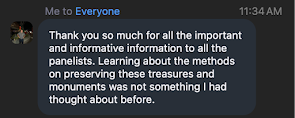Event Blog 1
Figures 1: Registration and Event
Figure 2: Discussion on Climate Change's effects towards Cultural Heritage (From event)
Two other speakers from the event that I found interesting were professor Alessandra Bonazza and Dr. Anthi Kaldeli, who highlights the importance of enhancing the setting and integrity of cultural heritage sites. It is more difficult to establish these safe-measures in places like Cyprus, where wildfires pose an extreme threat to heritage sites. Dr. Kaldeli did a great job at showing how fire risks have brought severe challenges for the preservation of art pieces in Cyprus. Similarly, the Department of Forests explains that the reasoning behind this crisis is due to the increase in temperature in Cyprus; along with “dry summer periods” and “vegetation characteristics” play key elements in the fire crisis and state of spread across Cyprus.
Figure 3: Climate Risks Index (From Event)
Alessandra Bonazza explains, in depth, ways that these sites can be preserved. She describes that in order to help cultural heritage sites from deterioration or vulnerability to the climate crisis there needs to be certain adaptive factors that do not hinder the structure or setting of the sites. Some of these adaptive factors include a site’s OUV, Outstanding Universal Value, accounts for potential risks, and overall adaptation that the structure can have. The preservation of these sites is best showcased by Lorenzo Quinn’s “Support” sculpture depicting two hands protecting a building from rising sea levels. More importantly, it expresses the urge to save these “treasures” that play an important role in the history of humanity. I highly recommend this event to everyone, because it gave me the necessary information regarding the preservation of cultural heritage sites, and the need to protect them.
Works Cited
Department of Forests. 2014.
ECMWF and the Union for the Mediterranean. “Risk to World Heritage Sites across the Mediterranean
from Rising Sea Levels.” https://stories.ecmwf.int/risks-to-world-heritage-sites-across-the-mediterranean-from-rising-sea-levels-under-climate-change/index.html Accessed 9 April 2024.
Lorenzo’s Quinn Sculpture ‘Support’ on display at the UN Climate Change Conference. 2-13 December,
2019. https://www.halcyongallery.com/news/9-lorenzo-quinn-s-sculpture-support-on-display-at-the/ Accessed 9 April 2024.




Comments
Post a Comment